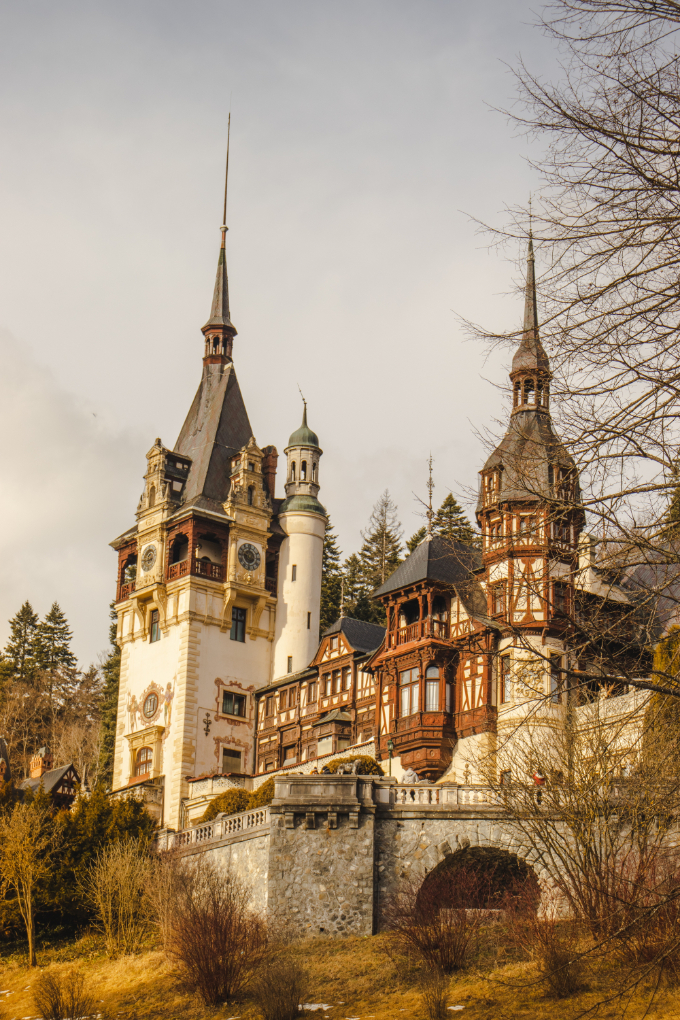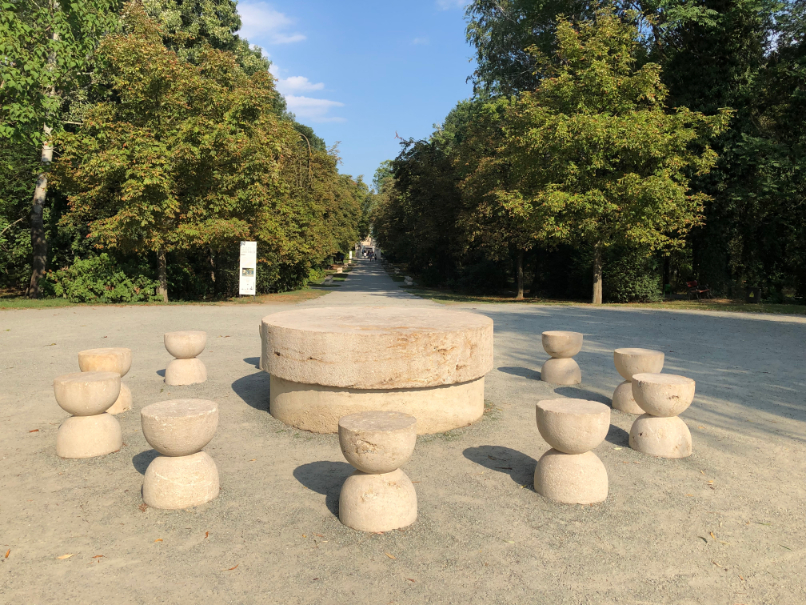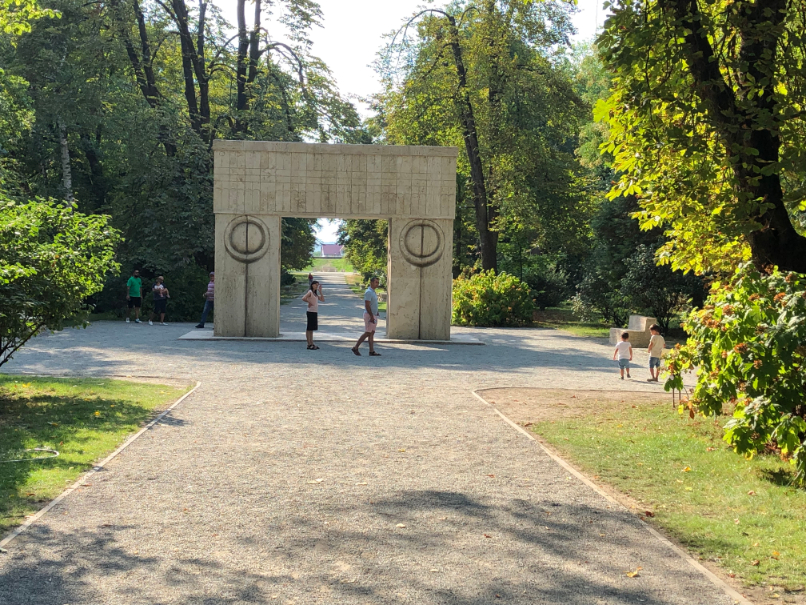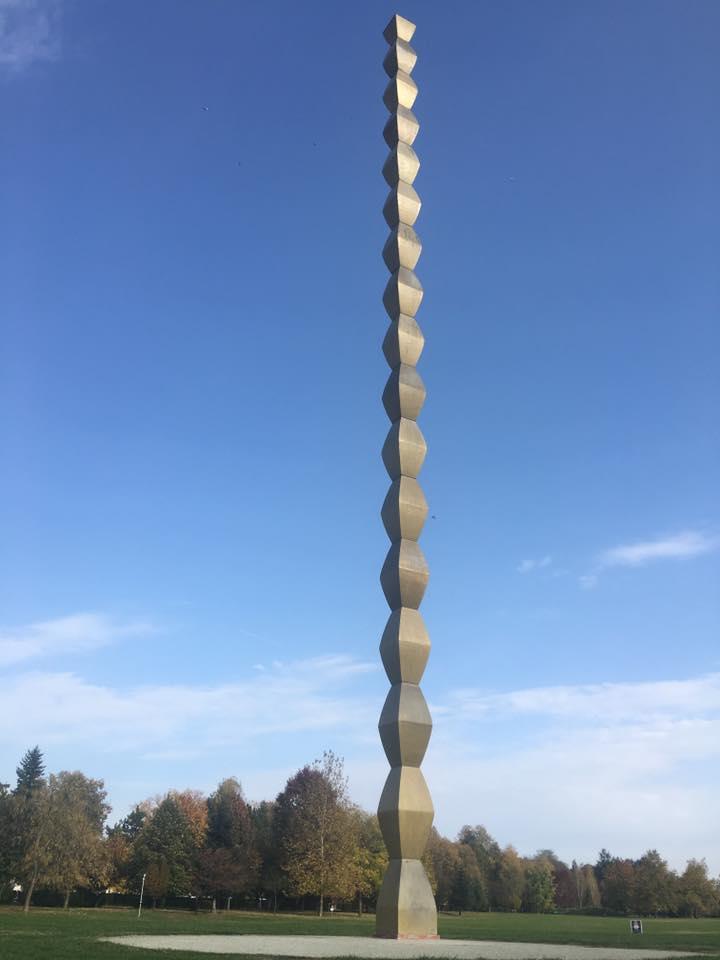Unit 6
Miercuri avem cursul de limba română
(On Wednesday we have the Romanian language class)

Photo: Peleș Castle(Castelul Peleș)
Photo: Peleș Castle(Castelul Peleș)
Unit 6: Miercuri avem cursul de limba română (On Wednesday we have the Romanian language class)
In this unit you will learn about:
• Daily Activities
• The Months of the Year
• The Days of the Week
• The Parts of the Day
• Telling the Time
Ce activități zilnice are Merve ?
What daily activities does Merve have?
Ea spune(She says):
Luni merg la cursuri, citesc, fac sport.
On Monday I go to school,read and I do sports.
Marti nu am cursuri, lucrez la computer, mă întalnesc cu prietenii mei studenți Erasmus și ne plimbăm prin Parcul Central.
On Tuesday I don’ t have classes,I work on the computer, I meet my Erasmus friends and walk in the Central Park.
 Photo:The Central Park, The Table of Silence(Parcul Central, Masa Tăcerii)
Photo:The Central Park, The Table of Silence(Parcul Central, Masa Tăcerii) Photo: The Central Park, The Gate of the Kiss (Parcul Central, Poarta Sărutului)
Photo: The Central Park, The Gate of the Kiss (Parcul Central, Poarta Sărutului)
Miercuri dimineața am cursul de română,și două seminare după-amiaza.
On Wednesday morning, I have the Romanian language class and two seminars in the afternoon.
Joi merg la cursuri, mă plimb prin parcul de la Coloana Infinitului.
On Thursday I go to school and I walk in the Endless Column Park.
 Photo: The Endless Column(Coloana Infinitului)
Photo: The Endless Column(Coloana Infinitului)
Vineri dimineața scriu un referat , apoi plec din Târgu-Jiu și merg la munte.
On Friday morning I write a seminar paper ,then I leave Târgu-Jiu and go to the mountains.
Sâmbătă vizitez castelul Peleș, și iau masa la un restaurant.
On Saturday I visit Peleș Castle and eat in a restaurant.
Duminică revin în Târgu-Jiu și mă pregătesc pentru săptămâna următoare.
On Sunday I come back to Târgu-Jiu and prepare for next week.
Practice
Underline the verbs in the text and say what tense they are.
Indicativul prezent (Present Indicative)
The dictionary verb form is the infinitive form.
The particle "a" is the'marker for infinitives, and it is placed in front of the verb
e.g.a citi (to read), a dansa (to dance), a vorbi(to speak) etc .
In order to form the Present Tense, we have to add some endings to the verb root. These endings are: 0/u (1st person singular), "-i" (2nd person singular), "-e/ă" (3rd person singular), "-em/im/ăm" (1st person plural), "-eți/iți/ ati" (2nd person plural), "-0/ă" (3rd person plural).
Pentru a forma prezentul, trebuie sa adăugăm niște terminații la rădăcina verbului. Aceste terminații sunt: 0/u (persoana 1 singular), -i (persoana a 2-a singular), -e/ă (persoana a 3-a singular), -em/im/ăm (persoana 1 plural), eți/iți /ați (persoana a 2-a plural), -0/ă (persoana a 3-a plural).
| Eu | merg | citesc | fac | lucrez | scriu | vizitez | manânc | revin |
|---|---|---|---|---|---|---|---|---|
| Tu | mergi | citești | faci | lucrezi | scrii | vizitezi | manânci | revii |
| El/ea | merge | citește | face | lucrează | scrie | vizitează | manâncă | revine | Noi | mergem | citim | facem | lucrăm | scriem | vizităm | mâncăm | revenim | Voi | mergeți | citiți | faceți | lucrați | scrieți | vizitați | mâncați | reveniți | Ei/ele | merg | citesc | fac | lucrează | scriu | vizitează | mănâncă | revin |
The same endings are added to the following group of verbs which are called reflexive verbs and are preceded by the particles mă,te,se,ne,vă,se according to the person they refer to.
| Eu | mă plimb | mă întâlnesc | mă pregătesc |
|---|---|---|---|
| Tu | te plimbi | te întâlnești | te pregătești |
| El/ea | se plimbă | se întâlnește | se pregătește | Noi | ne plimbăm | ne întâlnim | ne pregătim | Voi | vă plimbați | vă întâlniți | vă pregătiți | Ei/ele | se plimbă | se întâlnesc | se pregătesc |
| Persoana | Terminații | ||
|---|---|---|---|
| Eu | -0/u | ||
| Tu | -i | El/ea | -e/-ă | Noi | -em/im/ăm | Voi | -eți/iți/ați | Ei/ele | -0/ă |
Lunile anului (The months of the year)
| ianuarie | January | ||
|---|---|---|---|
| februarie | February | ||
| martie | March | aprilie | April | mai | May | iunie | June | iulie | July | august | August | septembrie | September | octombrie | October | noiembrie | November | decembrie | December |
Zilele săptămânii (The days of the week)
| luni | Monday |
|---|---|
| marți | Tuesday |
| miercuri | Wednesday |
| joi | Thursday |
| vineri | Friday |
| sâmbătă | Saturday |
| duminică | Sunday |
Părțile zilei (The parts of the day)
| Dimineață | Morning |
|---|---|
| Dimineața | In the morningy |
| Prânz | Noon |
| La prânz | At noon |
| După-amiaza | In the afternoon |
| Seara | In the evening |
| Noaptea | At night |
| La miezul noptii | At midnight |
Practice
1.Say what Merve does each day using the appropriate verbs
Example
Luni Merve merge la cursuri.
2.Make up 10 sentences saying what you do each day here , in Romania.
| Limba română | Limba engleză |
| Este (ora) cinci și cinci minute | It ‘s 5(minutes) past 5 o’clock |
| zece minute | 10(minutes) |
| un sfert | a quarter |
| douăzeci minute | 20 minutes |
| douăzeci și cinci | 25 minutes |
| de minute | |
| Este(ora) șase fără douăzeci și cinci (minute) | 25 minutes to 6 o’clock | |
| douăzeci(minute) | 20 minutes | |
| un sfert | a quarter | |
| zece (minute) | 10 minutes | |
| cinci( minute ) | 5 minutes | |
Practice:
1.Write the time in Romanian:
1.9.15
2.3.20
3.4.30
4.8.10
5.10.25
6.4.35
7.5.40
8.9.45.
9.8.55
10.7.50
2.Answer the following questions:
1.La ce oră te trezești dimineața?
2.La ce oră mergi la școală luni?
3.Când vii de la școală?
4.La ce oră ai cursuri joi?
5.Când aveți cursul de limba română?
6.Cât este ceasul acum?
7.Când te întâlnești cu prietenii tăi?
8.Când mergi la plimbare?
9.Când vizitați diferite locuri din România?(different places)
10.Când te întorci(go back) în țara ta?
A Glimpse of Romanian Culture:
Stratification in society
The bulk of the population is impoverished, and the overall standard of living in comparison to Western Europe is low. A small elite enjoyed privileges unimaginable to the majority of the population under communism. Ceaușescu, for example, resided in a forty-room castle with artwork from churches and museums adorning the walls. After Ceaucescu's overthrow, some of the old elite managed to keep their riches and power in the government. However, few people get above the average low quality of living.
It is also a mark of wealth to be able to send one's children to the best day-care centers and provide them with private tutoring.
The bulk of individuals in cities dress in Western-style attire. Some people still dress traditionally in rural areas. Wool skirts and vests for women are available, with needlework that differs by location. A white blouse and pants with a wool or leather belt and a cap or hat are required for men.
Roma people stand out in brightly colorful clothing all around the country. Men wear white shirts with colorful sashes, while women wear long flowing skirts.
(https://www.everyculture.com/No-Sa/Romania.html)
